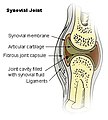Synovial fluid
Synovial fluid is a thick, stringy fluid found in the cavities of synovial joints. With its egg-like consistency (synovial comes from Latin for "egg"), synovial fluid reduces friction between the articular cartilage and other tissues in joints to lubricate and cushion them during movement.
Overview
The inner membrane of synovial joints is called the synovial membrane, which secretes synovial fluid into the joint cavity. This fluid forms a thin layer (approximately 50 micrometres) at the surface of cartilage, but also seeps into microcavities and irregularities in the articular cartilage surface, filling any empty space [1]. The fluid within articular cartilage effectively serves as a synovial fluid reserve. During normal movements, the synovial fluid held within the cartilage is squeezed out mechanically (so-called weeping lubrication) to maintain a layer of fluid on the cartilage surface.
Composition
Synovial tissue is composed of vascularized connective tissue that lacks a basement membrane. Two cells type (type A and type B) are present: type B produce synovial fluid. Synovial fluid is made of hyaluronic acid and lubricin, proteinases and collagenases. Synovial fluid exhibits non-Newtonian flow characteristics. The viscosity coefficient is not a constant, the fluid is not linearly viscous,and its viscosity increases as the shear rate decreases.
Normal synovial fluid contains 3-4 mg/ml hyaluronan (hyaluronic acid), a polymer of disaccharides composed of D-glucuronic acid and D-N-acetylglucosamine joined by alternating beta-1,4 and beta-1,3 glycosidic bonds [2]. Hyaluronan is synthesized by the synovial membrane and secreted into the joint cavity to increase the viscosity and elasticity of articular cartilages and lubricate the surfaces between synovium and cartilage.[3]
Synovial fluid also contains lubricin secreted by synovial cells. It is chiefly responsible for so-called boundary-layer lubrication, which reduces friction between opposing surfaces of cartilage. There is also some evidence that it helps regulate synovial cell growth.[4]
Health and disease
Collection
Synovial fluid can be collected by syringe in a procedure termed arthrocentesis, also known as joint aspiration.
Classification
Synovial fluid can be classified into normal, noninflammatory, inflammatory, septic, and hemorrhagic:
| Normal | Noninflammatory | Inflammatory | Septic | Hemorrhagic | |
| Volume (ml) | <3.5 | >3.5 | >3.5 | >3.5 | >3.5 |
| Viscosity | High | High | Low | Mixed | Low |
| Clarity | Clear | Clear | Cloudy | Opaque | Mixed |
| Color | Colorless/straw | Straw/yellow | Yellow | Mixed | Red |
| WBC/mm3 | <200 | 200-2,000 | 2,000-75,000 | >100,000 | Same as blood |
| Polys (%) | <25 | <25 | >50 | >75 | Same as blood |
| Gram stain | Negative | Negative | Negative | Often positive | Negative |
Pathology
Many synovial fluid types are associated with specific diagnoses [5] [6]:
- Noninflammatory (Group I)
- Osteoarthritis, degenerative joint disease
- Trauma
- Rheumatic fever
- Chronic gout or pseudogout
- Scleroderma
- Polymyositis
- Systemic lupus erythematosus
- Erythema nodosum
- Neuropathic arthropathy (with possible hemorrhage)
- Sickle-cell disease
- Hemochromatosis
- Acromegaly
- Amyloidosis
- Inflammatory (Group II)
- Rheumatoid arthritis
- Reactive arthritis
- Psoriatic arthritis
- Acute rheumatic fever
- Acute gout or pseuodgout
- Scleroderma
- Polymyositis
- Systemic lupus erythematosus
- Ankylosing spondylitis
- Inflammatory bowel disease arthritis
- Infection (viral, fungal, bacterial) including Lyme disease
- Acute crystal synovitis
- Septic (Group III)
- Hemorrhagic
- Trauma
- Tumors
- Hemophilia/coagulopathy
- Scurvy
- Ehlers-Danlos syndrome
- Neuropathic arthropathy
Joints cracking
When two parts forming a joint are pulled away from each other, the joint capsule increases in volume but the synovial fluid in the capsule no longer fills it all. Gases dissolved in the fluid quickly fill the empty space causing a sharp cracking sound.[7] The general term for this is cavitation.
Additional images
-
Synovial joint
References
- ^ http://www.ucl.ac.uk/~regfjxe/NORMALJOINT.htm
- ^ GlycoForum / Science of Hyaluronan-1
- ^ Arthritis - UW Medicine - Department of Orthopaedics and Sports Medicine
- ^ Arthritis Research & Therapy | Full text | Delineating biologic pathways involved in skeletal growth and homeostasis through the study of rare Mendelian diseases that affect bones and joints
- ^ Lupus Anticoagulant
- ^ American College of Rheumatology
- ^ Howstuffworks "What makes your knuckles pop?"
External links
- Warman W. "Delineating biologic pathways involved in skeletal growth and homeostasis through the study of rare Mendelian diseases that affect bones and joints." Arthritis Res. Ther. 2003, 5(Suppl 3):5 [1]
- Hyaluronan: structure and properties
- Synovial fluid analysis, from the American College of Rheumatology
- Template:FPnotebook
- Template:FPnotebook - white blood cell count
- Normal joint structure, from University College London

